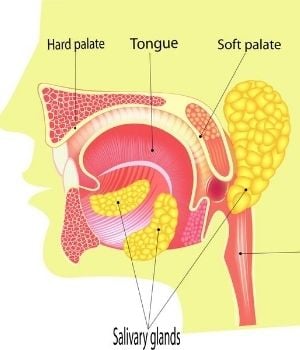About Your Salivary Glands
You have hundreds of salivary glands whose job it is to produce saliva which drains from ducts and moistens the inside of the mouth, helps protect against tooth decay, and helps you digest food. The three major salivary glands are:
- Parotid gland: This gland makes a quarter of the saliva you use. It drains into the mouth near the upper teeth.
- Submandibular gland: This produces 70 percent of your saliva, draining into the mouth from ducts under the tongue.
- Sublingual gland: This gland drains into the floor of the mouth, producing five percent of your saliva.
The rest of your salivary glands are minor glands located in your cheeks and lips, as well as in the lining of the throat and mouth.
What is a Salivary Gland Mass?
A salivary gland mass is a lump, or tumor, caused by abnormal cell growth. Although many people associate finding a mass with cancer, most masses are benign (noncancerous), but it’s still important to get any mass examined by a doctor. Ear, Nose, and Throat (ENT) specialists at C/V ENT Surgical Group have expertise at diagnosing and treating salivary gland masses.
A mass can develop in the salivary gland when some cells within the gland begin to mutate in their DNA, causing rapid cell division and growth and leading to an abnormal accumulation that forms a tumor.
Types of Benign Salivary Tumors
Most salivary gland masses are benign and most grow in the parotid gland. A common kind of salivary tumor are pleomorphic adenomas, which grow slowly and are more common in women than in men. They usually grow in the parotid gland, showing up first as a painless lump below the earlobe, but they can also show up in the submandibular and minor salivary glands.
Warthin’s tumor is a type of benign cystic tumor, also most commonly found in the parotid gland, showing up as a lump in front of the ear. This type of tumor is found much more in men than in women, especially in men over the age of 60.
Some rarer types of benign salivary gland masses include:
- Basal cell adenoma
- Monomorphic adenoma
- Canalicular adenoma
- Parotid gland oncocytoma
- Myoepithelioma
- Ductal papillomas
Cancerous Salivary Tumors
A mass becomes cancerous when additional mutations occur that lead to invasive and destructive cancer cells. If the cancer cells break away from a tumor and spread to other areas of the body from the salivary gland mass, this is known as metastasis. Cancerous salivary gland masses are rare and vary in how fast they develop.
The most common type of cancerous salivary gland mass is mucoepidermoid carcinoma, which make up more than 30 percent of all cancerous salivary gland masses and usually occur in the parotid gland. Adenoid cystic carcinoma and adenocarcinoma are two other of the more commonly seen types of cancerous salivary gland masses, occurring in the major and minor salivary glands.
Other kinds of cancerous salivary gland masses include:
- Acinic cell carcinoma
- Clear cell carcinoma
- Mucoepidermoid carcinoma
- Oncocytic carcinoma
- salivary duct carcinoma
- squamous cell carcinoma
What is NOT a Mass? Other Causes of Salivary Gland Enlargement
Swelling or enlargement of the salivary glands is not the same as a salivary gland mass, but it still is often a good idea to have a doctor check out swelling or enlargement that doesn’t subside. The salivary glands can swell or become enlarged from a number of causes, including:
- Cysts
- Salivary stones (sialolithiasis)
- Salivary gland infection (sialadenitis)
- Viral Infections (including influenza, mumps, Coxsackie viruses, echovirus, HIV, herpes, and cytomegalovirus)
- Sjögren’s syndrome
- Sialadenosis
Salivary Gland Mass Symptoms
Symptoms of a salivary gland mass may include:
- Swelling, enlargement, or a lump or bump near the jaw, in the neck, or in the mouth
- Difficulty swallowing or opening your mouth widely
- Numbness or muscle weakness that affects part of your face
- Pain in a salivary gland (below or behind the ears, in the jaw, under the tongue)
There is no way to know if a mass is benign or cancerous from symptoms alone. The symptoms of a salivary gland mass also may be similar to other treatable salivary gland disorders, so it’s a good idea to visit a ENT specialist if you experience them.
Risk Factors for Salivary Gland Masses
Although the cause of salivary gland masses isn’t fully known there are some factors that may increase your risk, especially for cancerous masses, including:
- Older age
- Sex (salivary gland cancers are more common in men)
- Exposure to radiation
- Exposure to nickel alloy dust, silica dust, or asbestos
- Some work environments, especially rubber manufacturing and plumbing
Diagnosing Salivary Gland Masses
In order to diagnose salivary gland masses, your ENT will take a medical history and perform an exam. Your doctor may order imaging tests, including X-rays, CT scans, and MRIs. To determine if a mass is cancerous, your doctor may order a fine-needle biopsy. Other tests, including those for salivary function or blood tests may also be ordered.
Treatment for Salivary Gland Masses
Once a salivary gland mass is diagnosed, your doctor will work with you on a treatment plan. Even benign masses are typically removed with surgery, and some may even require radiation therapy to prevent regrowth. Some cancerous masses can be treated with surgery alone, while others may require a more comprehensive treatment plan, including radiation and chemotherapy. If a salivary gland tumor is inoperable, radiation and chemotherapy may be used without surgery.
Parotid Surgery
Masses most often develop in the parotid gland, requiring parotid surgery. Because of the parotid gland’s proximity to important facial nerves, this is a delicate and demanding surgery, requiring specialized expertise. Our board-certified surgeons routinely perform parotid surgery in Los Angeles and Thousand Oaks to remove benign and malignant parotid masses. Learn more about parotid surgery and other salivary gland surgery at C/V Ent Surgical Group.
Contact Us for Concerns About a Salivary Gland Mass
If you have any symptoms of a salivary gland mass, it’s important to be evaluated by an expert ENT. Our renowned head and neck surgeons at C/V ENT Surgical Group are experts in the medical and surgical treatment of various salivary gland disorders. Contact our Encino office or our West Hills office today to schedule an appointment.


